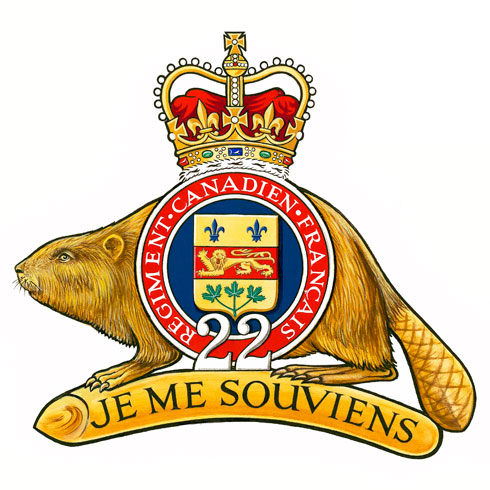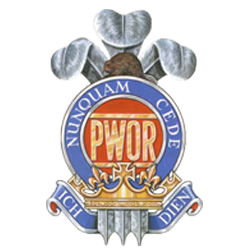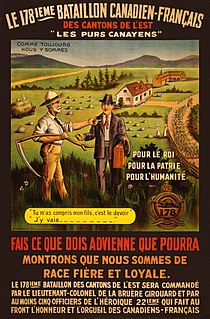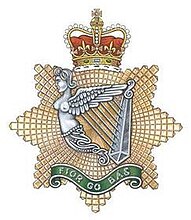
Les Fusiliers Mont-Royal is a Primary Reserve infantry regiment of the Canadian Army.

The Royal Regiment of Canada is a Primary Reserve infantry regiment of the Canadian Army based in Toronto, Ontario, part of 4th Canadian Division's 32 Canadian Brigade Group. Today, the regiment has a total of three companies:

The 12e Régiment blindé du Canada is a Canadian Army armoured regiment based in CFB Valcartier, on the outskirts of Quebec City. The regiment has both a Regular Force and a Primary Reserve unit. The 12e Régiment blindé du Canada's abbreviation is 12e RBC.

The Royal 22nd Regiment (R22R), or rather the Royal 22e Régiment in both English and French correct usage, and colloquially in English The Van Doos, or, in French, le Vingt-deuxième, is an infantry regiment of the Canadian Army. The mostly francophone regiment comprises three Regular Force battalions, two Primary Reserve battalions, and a band, making it the largest regiment in the Canadian Army. The "maison-mère" or home of the regiment is La Citadelle in Quebec City and is where the regimental museum is housed. The regimental headquarters is located in Quebec City, with all three of its regular battalions stationed at Canadian Forces Base Valcartier in Quebec. The regiment serves as the "local" infantry regiment for Quebec where it draws most of its recruits.

Les Voltigeurs de Québec is a Primary Reserve infantry regiment of the Canadian Forces. The name of the regiment commemorates another older French-speaking Canadian militia light infantry unit, the Canadian Voltigeurs. The founder of the Canadian Voltigeurs, lieutenant-colonel Charles-Michel d'Irumberry de Salaberry, was the father of the two men who raised Les Voltigeurs de Québec. The regiment was formed in March 1862, with its headquarters in Quebec City, by the amalgamation into a regiment of eight independent Volunteer Militia Rifle companies. The first of these companies was originally raised in December 1861. Between 1862 and 1867 these companies were frequently disbanded, reformed and renumbered. In 1942 it provided an armoured regiment.

The Princess of Wales' Own Regiment (PWOR) is a Primary Reserve infantry regiment of the Canadian Forces.

The 167th (Canadien-Français) Battalion, CEF was a unit in the Canadian Expeditionary Force during the First World War. Headquartered in Quebec City, Quebec, the unit began recruiting during the winter of 1915/16. The unit never sailed for England and on January 15, 1917, became the Quebec Recruiting Depot. The 167th (Canadien-Francais) Battalion, CEF had one Officer Commanding: Lieut-Col. O. Readman.

The 178th (Canadien-Français) Battalion, CEF was a unit in the Canadian Expeditionary Force during the First World War.
The 206th (Canadien-Francais) Battalion, CEF was a unit in the Canadian Expeditionary Force during the First World War.
The 163rd (Canadien-Francais) Battalion, CEF was a unit in the Canadian Expeditionary Force during the First World War. Based in Montreal, Quebec, the unit began recruiting in late 1915 throughout the province of Quebec. In May 1916, the battalion sailed for Bermuda, where it remained on garrison duty until late November of the same year. After arriving in England, the battalion was absorbed into the 10th Reserve Battalion on January 8, 1917. The 163rd (Canadien-Francais) Battalion, CEF had one Officer Commanding: Lieut-Col. H. DesRosiers.
The 230th Battalion, CEF was a unit in the Canadian Expeditionary Force during the First World War. Based in Ottawa, Ontario, the unit began recruiting in early 1916 in eastern Ontario, Hull, Quebec, and the surrounding district. The battalion also drew heavily from members of the 70th Regiment, based in Hull, Quebec. The battalion became the 230th Forestry Battalion in October 1916. This unit apparently sent six drafts overseas in 1917; these were on January 23 (SS Scandinavia), January 26 (SS Grampian), March 3 (SS Ausonia), May 3 (SS Justicia), June 2 (SS Olympic), and June 25.

The 2nd Battalion, Irish Regiment of Canada is a Primary Reserve infantry regiment of the Canadian Army based in Sudbury, Ontario. It is part of the 4th Canadian Division's 33 Canadian Brigade Group.

The Battle of Canal du Nord was part of the Hundred Days Offensive of the First World War by the Allies against German positions on the Western Front. The battle took place in the Nord-Pas-de-Calais region of France, along an incomplete portion of the Canal du Nord and on the outskirts of Cambrai between 27 September and 1 October 1918. To prevent the Germans from sending reinforcements against one attack, the assault along the Canal du Nord was part of a sequence of Allied attacks at along the Western Front. The attack began the day after the Meuse-Argonne Offensive commenced, a day before an offensive in Belgian Flanders and two days before the Battle of St. Quentin Canal.
The 69th Battalion (Canadien-Français), CEF was an infantry battalion of the Canadian Expeditionary Force during the Great War. The 69th Battalion was authorized on 10 July 1915 and embarked for Britain on 17 April 1916. The battalion provided reinforcements to the Canadian Corps in the field until 4 January 1917, when its personnel were absorbed by the 10th Reserve Battalion, CEF. The battalion was disbanded on 30 August 1920.

Arthur Mignault, MD was a French Canadian pharmaceutical entrepreneur, physician and colonel of the Royal Canadian Army Medical Corps, serving in the First World War. He is the founder of the Royal 22e Régiment, today the largest regiment of the Canadian Army.

The 2nd Canadian Mounted Rifles Battalion, was authorized on 7 November 1914 as the 2nd Regiment, Canadian Mounted Rifles, CEF. The battalion recruited in Victoria and Vernon, British Columbia and was mobilized in Victoria. An earlier incarnation was raised for Boer War.
The 57th Battalion (Canadien-Français), CEF was an infantry battalion of the Canadian Expeditionary Force during the Great War. The 57th Battalion was authorized on 20 April 1915 and embarked for Britain on 2 June 1916. On 8 June 1916, its personnel were absorbed by the 69th Battalion, CEF to provide reinforcements to the Canadian Corps in the field. The battalion was disbanded on 11 April 1918.
233rd or 233d may refer to:













